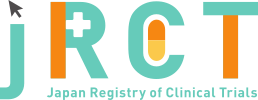臨床研究等提出・公開システム
|
Dec. 23, 2020 |
|
|
May. 13, 2024 |
|
|
jRCTs032200263 |
Confirmation of safety for patients with traumatic brain injury by transcranial direct current stimulation (TDCSTBI) |
|
tDCS study for TBI (TDCSTBI) |
|
Dec. 26, 2023 |
|
6 |
|
Between February 2021 and December 2022, 6 patients (3 male and 3 female) were enrolled in the prospective study. Five of the patients were in a MCS and 1 was classified as having a SD following a severe brain injury. The average age of injury was 43.7 years. The mean time from injury to tDCS was 778.3 days. All patients were evaluated during hospitalization. |
|
In cases 1 to 6, anodal stimulation was performed on the left dorsolateral frontal region at 2 mA for 20 minutes for 5 consecutive days, and no particular adverse effects were observed. In the variable stimulation period, in cases 1 to 5, anodal stimulation was applied to the right frontal region at 2 mA for 20 minutes once a week in the first course, the left frontal region at 2.5 mA for 20 minutes once a week in the second course, the left frontal region at 2 mA for 20 minutes once a week in the third course, and the left frontal region at 2.5 mA for 20 minutes once a week in the fourth course. In case 6, stimulation was applied over the left frontal region at 2 mA for 20 minutes for 5 consecutive days in the first and second courses, the left frontal region at 3 mA for 20 minutes for 5 consecutive days in the third course, and the left frontal region at 4 mA for 20 minutes for 5 consecutive days in the fourth course. |
|
tDCS stimulation was well tolerated for all 6 subjects in terms of the safety endpoint during the constant stimulus period, with no significant adverse effects including scalp burn and clinical seizure. Although one subject (case 4) underwent 3 days of antibiotics for aspiration pneumonia between courses 3 and 4 of the variable stimulus period, no modification of the treatment regimen was required. Furthermore, no new central nervous system-acting drugs were used during the treatment period in all cases. The incidence of serious adverse events was zero. No significant changes were observed in blood characteristics or head CT scan data between the screening phase, safety check phase, and after the end of the variable stimulation phase. |
|
The CRS-R scores showed an improvement of more than 1 point in 4 out of the 6 cases (66.7%). Three of the patients showed continuous neurological improvement during the observation period (Figure 2). In case 4, a transient improvement in neurological symptoms was observed after the second variable stimulus period. GCS scores improved by more than 1 point in 2 cases (33.3%) (Figure 3). One of these improvements was persistent and one was transient. Specifically, the level of consciousness improved from MCS without language to MCS with language in 2 patients (33.3%), 1 who had a permanent improvement and 1 who had a transient improvement. |
|
A phase I trial investigated the safety of transcranial direct current stimulation (tDCS) in patients with severe traumatic brain injury. They applied constant left frontal anodal stimulation at 2 mA for 20 minutes for 5 consecutive days, with additional variable stimuli to explore different parameters. The trial, following a traditional 3 + 3 study design, found no significant adverse events during both constant and variable stimulation periods. Patients showed improvement in neurological symptoms, with 4 |
|
Mar. 31, 2024 |
|
Feb. 23, 2024 |
|
https://doi.org/10.1016/j.dscb.2024.100123 |
No |
|
There is no plan to share the data. |
|
https://jrct.niph.go.jp/latest-detail/jRCTs032200263 |
Higuchi Yoshinori |
||
Chiba University Hospital |
||
1-8-1 Inohana, Chuo-ku, Chiba city |
||
+81-43-226-2158 |
||
yhiguchi@faculty.chiba-u.jp |
||
Higuchi Yoshinori |
||
Chiba University Hospital |
||
1-8-1 Inohana, Chuo-ku, Chiba city |
||
+81-43-226-2158 |
||
yhiguchi@faculty.chiba-u.jp |
Complete |
Dec. 23, 2020 |
||
| 6 | ||
Interventional |
||
single arm study |
||
open(masking not used) |
||
uncontrolled control |
||
single assignment |
||
treatment purpose |
||
1) Patients with a diagnosis of severe brain injury of 8 or less on the Glasgow Coma Scale (GCS) and requiring hospitalization follwoing 1-2 months after the injury. |
||
1) Patients who are unable to remain at rest |
||
| 16age old over | ||
| 80age old under | ||
Both |
||
Severe traumatic brain injury |
||
transcranial direct current stimulation |
||
traumatic brain injury, subdural hematoma, diffuse brain injury |
||
transcranial direct current stimulation |
||
D000070642, D006408, D000070625 |
||
D004599 |
||
Proportion of the following severe adverse events associated with the study device that occurred within the period of constant stimulation treatment will be evaluated. (number of patients occurring/number of patients) |
||
Neurological score (GCS, CRS-R) |
||
| Rehabilitation Center for Traumatic Apallics Chiba, National Agency for Automotive Safety and Victim | |
| Applicable |
| Chiba University Certified Clinical Research Review Board | |
| Inohana 1-8-1, Chuo-ku, Chiba city, Chiba | |
+81-43-226-2616 |
|
| prc-jim@chiba-u.jp | |
| Approval | |
Sept. 30, 2020 |
none |
